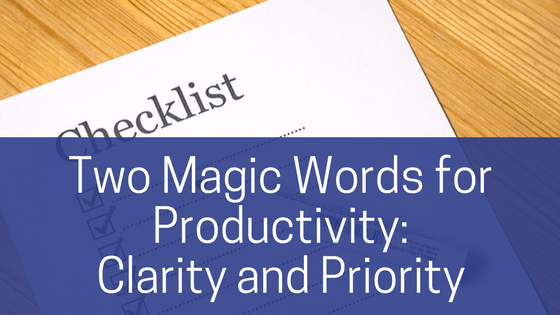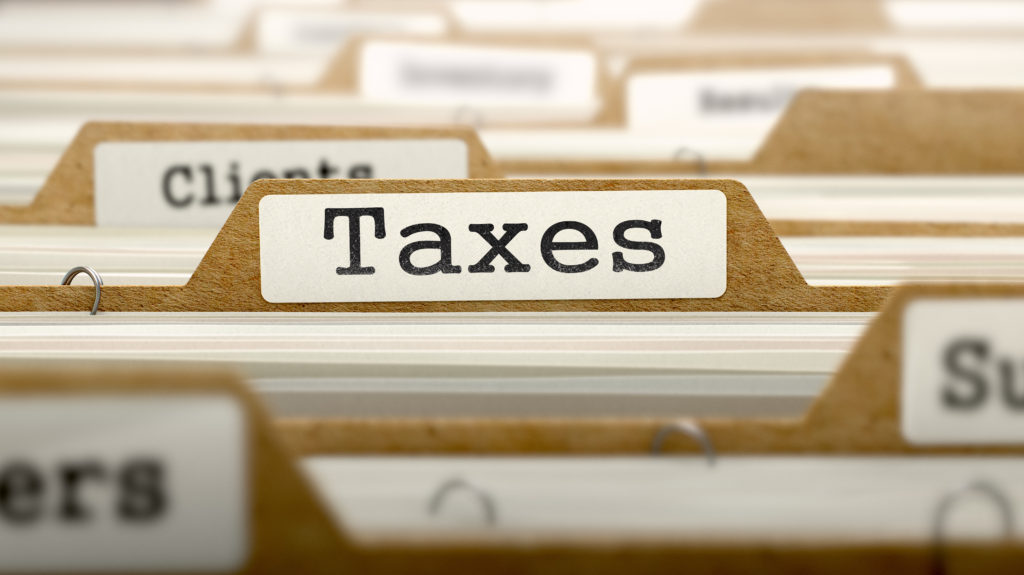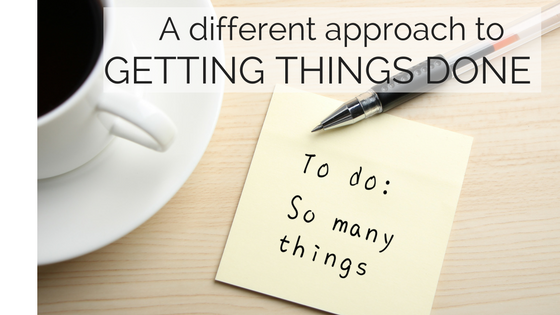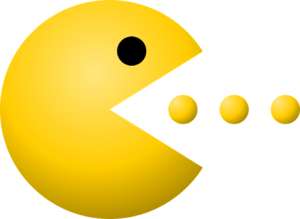
Motivation is, Unfortunately, Not Activation
There is often a collapse in our understanding when it comes to getting things done. We’re taught to believe that if we were really motivated, we would get started on that work project, organize the closet or declutter the entry. We’re told that if we really cared about our family’s health, we would consistently prepare tasty, nutritious meals. We tell ourselves that if we’re not exercising or finishing the online course we started, lack of willpower and poor self-image is to blame. If only we tried harder… Maybe, but not likely.
Activation, unlike motivation, is an executive function skill, also known as Initiation. That means it is brain-based in an area of our brain (the frontal lobes) that may not be as consistently high-performing as we’d like. Especially so for people with ADD / ADHD. This is the area of our brain that is largely responsible for things like organization, time management, prioritization and activation (the ability to get started on something). It is easily overwhelmed by too much to do, confusion as to how to do things, or the dread that comes when a project seems too big or boring to be easily accomplished.
That’s when the protective amygdala– the part of our brain that helps us to manage stress– steps in with its fight, flight or freeze response. So we go into avoidance mode. OK, this is an oversimplification, but it helps us to understand WHY we find that doing some things becomes so challenging that we continually procrastinate, even if we are motivated to get them done.
Just because we’ve decided to do something, doesn’t mean we will actually get it done – despite motivation by desire, rewards or dire consequences. This lack of ability to get going can be both frustrating and scary! Here are eight strategies to help you overcome overwhelm, minimize the avoidance factor, get activated and successfully accomplish your goals.
 Stop Identifying Yourself by Failure. Procrastinator. Lack of willpower. Lazy. Unmotivated. Selfish. Inconsiderate. Untrustworthy. These are words that make me want to quit, not put in the effort needed to overcome a brain-based executive function challenge. So recognize that despite the widespread ‘Just do it’ mentality, it’s often necessary to find work-arounds. Let go of the negative self-talk. Accept that you’re having difficulty beginning a task, and instead of being self-critical and judgmental (which accomplishes nothing), be gentle with yourself. You may be anxious about the task, uncertain about how to get it done, uncomfortable about doing it (like calling a company to complain about something), or stuck because you might ‘do it wrong.’ Avoid paralysis by analysis. Often all that’s needed is that first step, which is what activation is about. Identifying what is getting in the way is part of the solution. It’s important to take action despite your feelings, but it helps to understand them. Studies show that you’re 50% more effective if you first get clarity as to why it’s tough to get going, than you’d be if you just push through and try to get it done.
Stop Identifying Yourself by Failure. Procrastinator. Lack of willpower. Lazy. Unmotivated. Selfish. Inconsiderate. Untrustworthy. These are words that make me want to quit, not put in the effort needed to overcome a brain-based executive function challenge. So recognize that despite the widespread ‘Just do it’ mentality, it’s often necessary to find work-arounds. Let go of the negative self-talk. Accept that you’re having difficulty beginning a task, and instead of being self-critical and judgmental (which accomplishes nothing), be gentle with yourself. You may be anxious about the task, uncertain about how to get it done, uncomfortable about doing it (like calling a company to complain about something), or stuck because you might ‘do it wrong.’ Avoid paralysis by analysis. Often all that’s needed is that first step, which is what activation is about. Identifying what is getting in the way is part of the solution. It’s important to take action despite your feelings, but it helps to understand them. Studies show that you’re 50% more effective if you first get clarity as to why it’s tough to get going, than you’d be if you just push through and try to get it done.
 Set Aside Planning Time and Action Time. They are not the same. Planning time is for deciding exactly WHAT you are going to do, and HOW you’ll get it done. It’s the time to determine your priorities and decide WHEN you’ll actually work on your tasks (your Action times). It’s the time to make DECISIONS, so they don’t hold up your progress once you start working. Sometimes we plan to do something without being realistic about how much available time we actually have (the ‘white space’ in our calendars). So when planning, take all of your time commitments into account. And don’t overplan. Activation takes effort, so leave space for recharging, along with time to deal with interruptions, unexpected tasks or spill-overs from tasks that take longer than planned. If you skip Planning time and go directly to Action time, it’s easy to lose focus on what is most important and spend that Action time pursuing any new bright and shiny object (or checking emails, Facebook, Instagram, Twitter, Pinterest, etc.). If you haven’t planned very specific tasks for your Action time, it’s easy to get overwhelmed by all of the options when you are ready to work.
Set Aside Planning Time and Action Time. They are not the same. Planning time is for deciding exactly WHAT you are going to do, and HOW you’ll get it done. It’s the time to determine your priorities and decide WHEN you’ll actually work on your tasks (your Action times). It’s the time to make DECISIONS, so they don’t hold up your progress once you start working. Sometimes we plan to do something without being realistic about how much available time we actually have (the ‘white space’ in our calendars). So when planning, take all of your time commitments into account. And don’t overplan. Activation takes effort, so leave space for recharging, along with time to deal with interruptions, unexpected tasks or spill-overs from tasks that take longer than planned. If you skip Planning time and go directly to Action time, it’s easy to lose focus on what is most important and spend that Action time pursuing any new bright and shiny object (or checking emails, Facebook, Instagram, Twitter, Pinterest, etc.). If you haven’t planned very specific tasks for your Action time, it’s easy to get overwhelmed by all of the options when you are ready to work.
 Use your Planning time to gain CLARITY. What are the specific tasks that will enable you to make progress towards your goal? A project is too big to ‘do’ in one sitting, so the thought of ‘doing’ an entire project is overwhelming, resulting in avoidance rather than clarity. It’s easier to activate when there’s something very specific to do, with no conflicting priorities and a set time for starting –and ending– your efforts. It’s the way you solve that proverbial question, “How do you eat an elephant?” (the project you tend to avoid because it’s just too big, scary or unappetizing). How? One bite at a time! Begin by breaking the project into do-able tasks, or individual bites that aren’t too painful to swallow. The smaller you make them, the easier they’ll fit into your busy schedule. Prioritize those tasks (what has to be done before you can move on to the next task?). WRITE DOWN THE STEPS! Then, when you are in Action time, put on your blinders to stay focused on the designated task.
Use your Planning time to gain CLARITY. What are the specific tasks that will enable you to make progress towards your goal? A project is too big to ‘do’ in one sitting, so the thought of ‘doing’ an entire project is overwhelming, resulting in avoidance rather than clarity. It’s easier to activate when there’s something very specific to do, with no conflicting priorities and a set time for starting –and ending– your efforts. It’s the way you solve that proverbial question, “How do you eat an elephant?” (the project you tend to avoid because it’s just too big, scary or unappetizing). How? One bite at a time! Begin by breaking the project into do-able tasks, or individual bites that aren’t too painful to swallow. The smaller you make them, the easier they’ll fit into your busy schedule. Prioritize those tasks (what has to be done before you can move on to the next task?). WRITE DOWN THE STEPS! Then, when you are in Action time, put on your blinders to stay focused on the designated task.
 Make the Task more Appealing. How can you turn a need-to, should-do or must-do into a want-to? Same task, different attitude. Even then activation may be difficult, but it’s easier when you see a positive reason for accomplishing a task (even if it’s just to get it over with so it no longer gives you angst!). How can you add a fun element to the task? Some ideas: Do it with a friend, working together or just in parallel play… get out of your home or office and work in a coffee shop or park… upgrade your writing tools with a special pen and appealing notebook… promise yourself a reward for getting the task accomplished (even if it’s just some guilt-free ‘me’ time)… make finishing the task a game… have a giant check-off list, etc. Or try one of my favorites: get to work on it to avoid doing a task that’s even less appealing! Remember the benefit. Write down what you will gain from finishing the task. Keeping the goal in mind can make the work that goes into accomplishing it less onerous.
Make the Task more Appealing. How can you turn a need-to, should-do or must-do into a want-to? Same task, different attitude. Even then activation may be difficult, but it’s easier when you see a positive reason for accomplishing a task (even if it’s just to get it over with so it no longer gives you angst!). How can you add a fun element to the task? Some ideas: Do it with a friend, working together or just in parallel play… get out of your home or office and work in a coffee shop or park… upgrade your writing tools with a special pen and appealing notebook… promise yourself a reward for getting the task accomplished (even if it’s just some guilt-free ‘me’ time)… make finishing the task a game… have a giant check-off list, etc. Or try one of my favorites: get to work on it to avoid doing a task that’s even less appealing! Remember the benefit. Write down what you will gain from finishing the task. Keeping the goal in mind can make the work that goes into accomplishing it less onerous.
 Think Progress, not Perfection. It’s easier to eat the elephant (work on that task or project) when you feel like it, or when you’re really hungry (deadline anyone?). But that’s a less effective way of ensuring you successfully accomplish your business or personal goals than if you were to commit to taking small, palatable bites every day (consistent effort). Prioritize the bites and keep them small, triumphing over your perfectionistic avoidance tendencies. Consistent small bites get things done!
Think Progress, not Perfection. It’s easier to eat the elephant (work on that task or project) when you feel like it, or when you’re really hungry (deadline anyone?). But that’s a less effective way of ensuring you successfully accomplish your business or personal goals than if you were to commit to taking small, palatable bites every day (consistent effort). Prioritize the bites and keep them small, triumphing over your perfectionistic avoidance tendencies. Consistent small bites get things done!
 Take a Short Detour to Gain Momentum. Sitting and staring at a blank screen won’t get that blog written. First, try doing a tiny action, like writing one sentence. This small action will often get you over the inertia hump, so you can continue. But if you find yourself unable to initiate action, take a detour. Do something physical (energizes your body and your mind). Take a short nature break (relaxes the anxiety and provides a feeling of well-being you can take back to your desk). Call a positive friend and make plans to do something fun. Listen to music that energizes and helps you stay focused. Make sure you eat and drink (dehydration contributes to brain fog). If you take medication, check that you’ve taken it. If you need ten minutes of down time, take it – even if it’s to check your social media or email (be safe and set a STOP alarm!). Remind yourself of your commitment to get to your Action task, and then, refreshed, get back to work.
Take a Short Detour to Gain Momentum. Sitting and staring at a blank screen won’t get that blog written. First, try doing a tiny action, like writing one sentence. This small action will often get you over the inertia hump, so you can continue. But if you find yourself unable to initiate action, take a detour. Do something physical (energizes your body and your mind). Take a short nature break (relaxes the anxiety and provides a feeling of well-being you can take back to your desk). Call a positive friend and make plans to do something fun. Listen to music that energizes and helps you stay focused. Make sure you eat and drink (dehydration contributes to brain fog). If you take medication, check that you’ve taken it. If you need ten minutes of down time, take it – even if it’s to check your social media or email (be safe and set a STOP alarm!). Remind yourself of your commitment to get to your Action task, and then, refreshed, get back to work.
 Be Aware of Transition Trauma. Sometimes it’s hard to stop one activity to begin another. Our brains just don’t want to make the switch. Be clear as to what you plan to do when. Write it on your Daily Action List. Put it in your calendar as a Task-Appointment. Use alarms to define your Action times and alert you that it’s time to begin (activate). Get up and move between activities so you can clear the Zombie-like focus, or hyperfocus, from a previous task (or from that computer solitaire marathon session).
Be Aware of Transition Trauma. Sometimes it’s hard to stop one activity to begin another. Our brains just don’t want to make the switch. Be clear as to what you plan to do when. Write it on your Daily Action List. Put it in your calendar as a Task-Appointment. Use alarms to define your Action times and alert you that it’s time to begin (activate). Get up and move between activities so you can clear the Zombie-like focus, or hyperfocus, from a previous task (or from that computer solitaire marathon session).
 Find an Accountability Partner. When someone else cares whether we’ve accomplished what we said we would, we’re more likely to get it done. This is often difficult when you work alone. Just as it’s easier to get to the gym when you go with a friend, it’s easier to get activated and work towards your goals when there are others who are supportive of your efforts and cheerleaders for overcoming your challenges. Share with a non-judgmental friend, join a mastermind group, consider the benefits of individual coaching, or join a group like my TUIT Project, which is designed to provide support and accountability. A new online group begins each month–visit OvercomeOverwhelm.com.
Find an Accountability Partner. When someone else cares whether we’ve accomplished what we said we would, we’re more likely to get it done. This is often difficult when you work alone. Just as it’s easier to get to the gym when you go with a friend, it’s easier to get activated and work towards your goals when there are others who are supportive of your efforts and cheerleaders for overcoming your challenges. Share with a non-judgmental friend, join a mastermind group, consider the benefits of individual coaching, or join a group like my TUIT Project, which is designed to provide support and accountability. A new online group begins each month–visit OvercomeOverwhelm.com.
Also consider the benefits of individual coaching. Contact Susan Lasky Productivity Solutions to discuss how coaching could help you move forward and have a less stressful, more fulfilling life. Susan is based in Westchester, but works virtually anywhere. She can be reached at 914-373-4787 or Susan@SusanLasky.com. You can schedule a convenient, no-cost or obligation Initial Consult at https://SusanLasky.AcuityScheduling.com.















